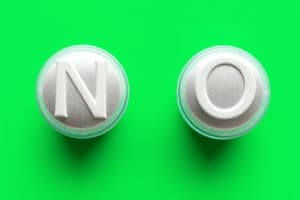Podcast
Questions and Answers
What is a characteristic of endothermic reactions?
What is a characteristic of endothermic reactions?
- They do not change temperature.
- They always involve gases.
- They absorb heat. (correct)
- They release heat.
Molar mass is the mass of one mole of a substance used for conversions in stoichiometry.
Molar mass is the mass of one mole of a substance used for conversions in stoichiometry.
True (A)
What is the term for the substance that is dissolved in a solution?
What is the term for the substance that is dissolved in a solution?
solute
A solution with a high amount of solute in a given volume is said to have a high ______.
A solution with a high amount of solute in a given volume is said to have a high ______.
Match the following functional groups with their corresponding compounds:
Match the following functional groups with their corresponding compounds:
What is the fundamental unit of matter?
What is the fundamental unit of matter?
Gases have a definite shape and a definite volume.
Gases have a definite shape and a definite volume.
What is formed when two or more elements chemically bond?
What is formed when two or more elements chemically bond?
In the periodic table, __________ are highly reactive nonmetals known for forming salts with metals.
In the periodic table, __________ are highly reactive nonmetals known for forming salts with metals.
What type of bond involves the sharing of free electrons among a lattice of metal atoms?
What type of bond involves the sharing of free electrons among a lattice of metal atoms?
Match the following states of matter with their characteristics:
Match the following states of matter with their characteristics:
Acids have a pH greater than 7.
Acids have a pH greater than 7.
What is the outcome of a neutralization reaction?
What is the outcome of a neutralization reaction?
Flashcards are hidden until you start studying
Study Notes
Key Concepts in Chemistry
1. Basic Terminology
- Atom: Fundamental unit of matter, composed of protons, neutrons, and electrons.
- Element: Pure substance made of one type of atom; found on the periodic table.
- Compound: Substance formed when two or more elements chemically bond.
- Molecule: Smallest unit of a compound that retains its chemical properties.
2. States of Matter
- Solid: Definite shape and volume; particles are tightly packed.
- Liquid: Definite volume but no definite shape; particles are close but can move around.
- Gas: No definite shape or volume; particles are far apart and move freely.
- Plasma: Ionized gas with charged particles; higher energy than gas.
3. Chemical Bonds
- Ionic Bonds: Formed through the transfer of electrons; usually between metals and nonmetals.
- Covalent Bonds: Formed by sharing electrons; typically occur between nonmetals.
- Metallic Bonds: Involves the sharing of free electrons among a lattice of metal atoms.
4. Chemical Reactions
- Reactants: Substances that undergo change during a reaction.
- Products: New substances formed as a result of a chemical reaction.
- Types of Reactions:
- Synthesis: Formation of a compound from simpler substances.
- Decomposition: Breakdown of a compound into simpler substances.
- Single Replacement: One element replaces another in a compound.
- Double Replacement: Exchange of ions between two compounds.
5. The Periodic Table
- Organized by increasing atomic number.
- Groups/Families: Vertical columns; elements have similar chemical properties.
- Periods: Horizontal rows; elements show varying properties across a period.
- Key Groups:
- Alkali Metals (Group 1): Highly reactive, soft metals.
- Alkaline Earth Metals (Group 2): Reactive metals, but less so than alkali metals.
- Transition Metals: Metals with variable oxidation states and complex ions.
- Halogens (Group 17): Nonmetals; very reactive, forming salts with metals.
- Noble Gases (Group 18): Inert gases, very low reactivity.
6. Acids and Bases
- Acids: Substances that release protons (H+) in solution; pH < 7.
- Bases: Substances that accept protons or release hydroxide ions (OH-); pH > 7.
- Neutralization: Reaction between an acid and a base producing salt and water.
7. Stoichiometry
- Study of quantitative relationships in chemical reactions.
- Reactant/Product Ratios: Use coefficients from balanced chemical equations to calculate amounts.
- Molar Mass: Mass of one mole of a substance; used for conversions in stoichiometry.
8. Thermodynamics in Chemistry
- Endothermic Reactions: Absorb heat, leading to a drop in temperature.
- Exothermic Reactions: Release heat, causing an increase in temperature.
- Law of Conservation of Energy: Energy cannot be created or destroyed, only transformed.
9. Solution Chemistry
- Solute: Substance dissolved in a solvent.
- Solvent: Substance in which the solute is dissolved.
- Concentration: Measure of the amount of solute in a given volume of solution (e.g., molarity).
10. Organic Chemistry
- Study of carbon-containing compounds.
- Functional Groups: Specific groups of atoms within molecules that determine chemical reactivity and properties (e.g., -OH for alcohols, -COOH for carboxylic acids).
This concise overview covers fundamental concepts and principles in chemistry, providing a framework for more detailed study.
Basic Terminology
- Atom: The smallest unit of an element, made up of protons, neutrons, and electrons.
- Element: A pure substance made of only one type of atom. Elements are organized on the periodic table.
- Compound: A substance formed when two or more different elements chemically combine.
- Molecule: The smallest unit of a compound that retains the chemical properties of that compound.
States of Matter
- Solid: Has a definite shape and volume. Particles in a solid are tightly packed and vibrate in place.
- Liquid: Has a definite volume but takes the shape of its container. Particles in a liquid are close together but can move around.
- Gas: Has no definite shape or volume. Particles in a gas are far apart and move freely.
- Plasma: Very high-energy, ionized gas consisting of charged particles. Plasma has a higher energy state than a gas.
Chemical Bonds
- Ionic Bonds: Formed by the transfer of electrons from one atom to another. Ionic bonds typically occur between metals and nonmetals. The metal atom loses electrons to become a positively charged cation, while the nonmetal atom gains electrons to become a negatively charged anion.
- Covalent Bonds: Formed by the sharing of electrons between two atoms. Covalent bonds usually form between nonmetals.
- Metallic Bonds: Formed by the sharing of free electrons among a lattice of metal atoms.
Chemical Reactions
- Reactants: The starting substances in a chemical reaction.
- Products: The new substances formed as a result of a chemical reaction.
- Types of reactions:
- Synthesis: Two or more simple substances combine to form a more complex compound.
- Decomposition: A complex compound is broken down into simpler substances.
- Single Replacement: One element replaces another element in a compound.
- Double Replacement: Two compounds exchange ions, often forming a precipitate, a gas, or water.
The Periodic Table
- Organized by increasing atomic number. The number of protons an element has determines its place on the periodic table.
- Groups/Families: Vertical columns on the periodic table. Elements in the same group have similar chemical properties due to their similar electron configurations.
- Periods: Horizontal rows on the periodic table. Elements in the same period have varying properties as the number of electron shells increases across the row.
- Key Groups:
- Alkali Metals (Group 1): Highly reactive, soft metals. They readily lose their outermost electron to form +1 cations.
- Alkaline Earth Metals (Group 2): Reactive metals, but less so than alkali metals. They readily lose their two outermost electrons to form +2 cations.
- Transition Metals: Metals with variable oxidation states, meaning they can lose different numbers of electrons to form ions with different charges. Many transition metals form complex ions with other molecules and ions.
- Halogens (Group 17): Very reactive nonmetals that readily gain one electron to form -1 anions. They react with metals to form salts.
- Noble Gases (Group 18): Inert gases with very low reactivity because their outer electron shell is filled. These gases are often used in lighting applications.
Acids and Bases
- Acids release hydrogen ions (H+) in solution. They have a pH less than 7. Acids often taste sour and can react with bases to neutralize them.
- Bases accept hydrogen ions (H+) or release hydroxide ions (OH-) in solution. They have a pH greater than 7. Bases often taste bitter and feel slippery. They can react with acids to neutralize them.
- Neutralization: The reaction between an acid and a base, producing salt and water as products. The salt produced is typically an ionic compound.
Stoichiometry
- Quantitative relationships in chemical reactions. Stoichiometry uses the balanced chemical equation to determine the relative amounts of reactants and products in a chemical reaction.
- Reactant/Product Ratios: The coefficients in a balanced chemical equation represent the relative number of moles of each reactant and product.
- Molar Mass: The mass of one mole of a substance. The molar mass is a conversion factor used in stoichiometry to calculate the mass or number of moles of a substance. One mole of a substance contains Avogadro's number of particles (6.022 x 10^23).
Thermodynamics in Chemistry
- Endothermic Reactions: Absorb heat from their surroundings. These reactions cause the temperature of the surroundings to decrease.
- Exothermic Reactions: Release heat to their surroundings. These reactions cause the temperature of the surroundings to increase.
- Law of Conservation of Energy: Energy cannot be created or destroyed, only transformed from one form to another. Energy is often converted between heat, light, chemical energy, or mechanical energy.
Solution Chemistry
- Solute: The substance that dissolves in a solvent. In a salt water solution, salt is the solute.
- Solvent: The substance that dissolves the solute. In a salt water solution, water is the solvent.
- Concentration: The amount of solute dissolved in a given volume of solution. The concentration of a solution can be expressed in several ways, including molarity (moles of solute per liter of solution).
Organic Chemistry
- Organic Chemistry: The study of carbon-containing compounds. Carbon has the ability to bond to itself and other elements to form a wide variety of molecules.
- Functional Groups: Specific groups of atoms within organic molecules that determine their chemical reactivity and properties. For example, the -OH (hydroxyl) group is characteristic of alcohols, and the -COOH (carboxyl) group is characteristic of carboxylic acids.
Studying That Suits You
Use AI to generate personalized quizzes and flashcards to suit your learning preferences.




